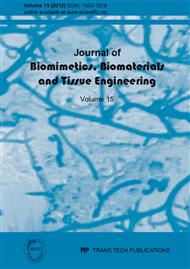[1]
J. M Cloyd, N. R Malhotra, L. Weng, W. Chen, R. L Mauck, D. M Elliott. Material properties in unconfined compression of human nucleus pulposus, injectable hyaluronic acid-based hydrogels and tissue engineering scaffolds. Eur. Spine J. 2007, 16, 1892.
DOI: 10.1007/s00586-007-0443-6
Google Scholar
[2]
S. S Jang, W. A Goddard, M. Yashar, S. Kalani. Mechanical and transport properties of the poly(ethylene oxide)-poly(acrylic acid) double network hydrogel from molecular dynamic simulations. J. Phys. Chem. B. 2007, 111, 1729.
DOI: 10.1021/jp0656330
Google Scholar
[3]
J. Elisseeff, M. Ruffner, T. G Kim, C. Williams. Cellular Photoencapsulation in Hydrogels. Wiley-Interscience: New York, 2006, chap. 9, p.215.
Google Scholar
[4]
T. Wang, M. Turhan, S. Gunasekaran. Selected properties of pH-sensitive, biodegradable chitosan-poly(vinyl alcohol) hydrogel. Polym. Int. 2004, 53, 911.
DOI: 10.1002/pi.1461
Google Scholar
[5]
D. T Mathews, Y. A Birney, P. A Cahill, G. B McGuinness. Vascular cell viability on polyvinyl alcohol hydrogels modified with water-soluble and insoluble Chitosan. J. Biomed. Mater. Res. Part B: Appl. Biomater. 2008, 84, 531.
DOI: 10.1002/jbm.b.30901
Google Scholar
[6]
H. Yu, X. Xu, X. Chen, J. Hao, X. Jing. Medicated wound dressings based on poly(vinyl alcohol)/poly(N-vinyl pyrrolidone)/chitosan hydrogels. J. Appl. Polym. Sci. 2006, 101, 2453.
DOI: 10.1002/app.23344
Google Scholar
[7]
D. C Charlton, M.G. E Peterson, K. Spiller, A. Lowman, P. A Torzilli, S. A Maher. Semi-degradable scaffold for articular cartilage replacement. Tissue Eng. Part A. 2008, 14, 207.
DOI: 10.1089/ten.a.2006.0344
Google Scholar
[8]
C. M Paranhos, R. N Oliveira, B. G Soares, L. A Pessan. Poly(vinyl alcohol)/sulfonated polyester hydrogels produced by freezing and thawing technique: preparation and characterization. Mater. Res. 2007, 10, 43.
DOI: 10.1590/s1516-14392007000100010
Google Scholar
[9]
S. Bonakdar, F. Orang, M. Rafienia, R. Imani. Comparison of the effect of hydrophilicity on biocompatibility and platelet adhesion of two different kinds of biomaterials. Iran. J. Pharm. Sci. 2008, 4, 37.
Google Scholar
[10]
Y. Tabata. Biomaterials design of culture substrates for cell research. Inflammation and regeneration. 2011, 31, 137.
Google Scholar
[11]
J. Du, S. Zhang, R. Sun, L. F Zhang, C. D Xiong, Y. X Peng. Novel polyelectrolyte carboxymethyl konjac glucomannan-chitosan nanoparticles for drug delivery. II. release of albumin in vitro. J. Biomed. Mater. Res. B Appl. Biomater. 2005, 72, 299.
DOI: 10.1002/jbm.b.30156
Google Scholar
[12]
A. Lahiji, A. Sohrabi, D. S Hungerford, C. G Frondoza. Chitosan supports the expression of extracellular matrix proteins in human osteoblasts and chondrocytes. J. Biomed. Mater. Res. 2000, 51, 586.
DOI: 10.1002/1097-4636(20000915)51:4<586::aid-jbm6>3.0.co;2-s
Google Scholar
[13]
V. B Kotwal, M. Saifee, N. Inamdar, K. Bhise. Biodegradable polymers: which, when and why?. Indian J. Pharm. Sci. 2007, 69, 616.
DOI: 10.4103/0250-474x.38465
Google Scholar
[14]
B. Baroli. Hydrogels for tissue engineering and delivery of tissue-inducing substances. J. Pharm. Sci. 2007, 96, 2197.
DOI: 10.1002/jps.20873
Google Scholar
[15]
H. Yu, W. Wang, X. Chen, C. Deng, X. Jing. Synthesis and characterization of the biodegradable polycaprolactone-graft-chitosan amphiphilic copolymers. Biopolymers. 2006, 83, 233.
DOI: 10.1002/bip.20551
Google Scholar
[16]
N. E Fedorovich, J. Alblas, J. R De Wijn, W. E Hennink, A. J Verbout, W. J Dhert. Hydrogels as extracellular matrices for skeletal tissue engineering: state-of-the art and novel application in organ printing-A review. Tissue Eng. 2007, 13, (1905).
DOI: 10.1089/ten.2006.0175
Google Scholar
[17]
P. R Dallan, P. L Moreira, L. Petinari, S. M Malmonge, M. M Beppu, S. C Genari, A. M Moraes. Effects of chitosan solution concentration and incorporation of chitin and glycerol on dense chitosan membrane properties. J. Biomed. Mater. Res. B: Appl. Biomater. 2007, 80, 394.
DOI: 10.1002/jbm.b.30610
Google Scholar
[18]
C. Huin-Amargier, P. Marchal, E. Payan, P. Netter, E. Dellacherie. New physically and chemically crosslinked hyaluronate (HA)-based hydrogels for cartilage repair. J. Biomed. Mater. Res. 2006, 76, 416.
DOI: 10.1002/jbm.a.30536
Google Scholar
[19]
X. Jiang, H. Dai, K. W Leong, S. H Goh, H. Q Mao, Y.Y. Yang. Chitosan-g-PEG/DNA complexes deliver gene to the rat liver via intrabiliary and intraportal infusions. J. Gene Med. 2006, 8, 477.
DOI: 10.1002/jgm.868
Google Scholar
[20]
J. W Wang, M. H Hon. Sugar-mediated chitosan/poly(ethylene glycol)-beta-dicalcium pyrophosphate composite: Mechanical and microstructural properties. J. Biomed. Mater. Res. 2003, 64, 262-272.
DOI: 10.1002/jbm.a.10358
Google Scholar
[21]
K. Kurita. Chitin and chitosan: functional biopolymers from marine crustaceans. Mar. Biotechnol. 2006, 8, 203.
DOI: 10.1007/s10126-005-0097-5
Google Scholar
[22]
U. S Sajeev, K. A Anand, D. Menon, S. Nair. Control of nanostructures in PVA, PVA/chitosan blends and PCL through electrospinning. Bull. Mater. Sci. 2008, 31, 343.
DOI: 10.1007/s12034-008-0054-9
Google Scholar
[23]
N. Minoura, T. Koyano, N. Koshizaki, H. Umehara, M. Nagura, K. Kobayashi. Preparation, properties, and cell attachment/growth behaviour of PVA/chitosan-blended hydrogels. Mater. Sci. Eng. 1998, 6, 275.
DOI: 10.1016/s0928-4931(98)00062-9
Google Scholar
[24]
E. S Costa-Júnior, E. F Barbosa-Stancioli, A.A. P Mansur, W. L Vasconcelos, H. S Mansur. Preparation and characterization of chitosan/poly(vinylalcohol) chemically crosslinked blends for biomedical applications. Carbohydr. Polym. 2009, 76, 472.
DOI: 10.1016/j.carbpol.2008.11.015
Google Scholar
[25]
J. Berger, M. Reist, J. M Mayer, O. Felt, R. Gurny. Structure and interactions in chitosan hydrogels formed by complexation or aggregation for biomedical applications. Eur. J. Pharm. Biopharm. 2004, 57, 35.
DOI: 10.1016/s0939-6411(03)00160-7
Google Scholar
[26]
K. Kachi, N. Tomita, K. Yamamoto, R. Takaya, Y. Tamada. Tribological maturation of regenerated cartilage was inhibited by using chondrocyte aggregates. J. Biomech. Sci. Eng. 2009, 4, 174.
DOI: 10.1299/jbse.4.174
Google Scholar
[27]
H.P. S Abdul Khalil, M. Jawaid, A. Abu Bakar. Woven hybrid composites: water absorption and thickness swelling behaviours. BioRes. 2011, 6, 1043.
Google Scholar
[28]
C. S Wu, H. T Liao. A new biodegradable blends prepared from polylactide and hyaluronic acid. Polym. 2005, 46, 10017.
DOI: 10.1016/j.polymer.2005.08.056
Google Scholar
[29]
Y. Liu, N. E Vrana, P. A Cahill, G. B McGuinness. Physically crosslinked composite hydrogels of PVA with natural macromolecules: structure, mechanical properties, and endothelial cell compatibility. J. Biomed. Mater. Res. B: Appl. Biomater. 2009, 90, 492.
DOI: 10.1002/jbm.b.31310
Google Scholar
[30]
Y. Zhao, T. Tan. Poly(aspartic acid) super-absorbent resin produced by chemical crosslinking and physical freeze/thawing. Macromol. Chem. Phys. 2006, 207, 1297.
DOI: 10.1002/macp.200600168
Google Scholar


